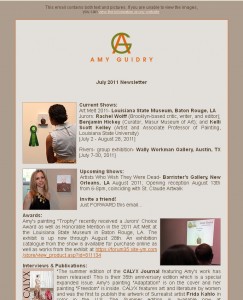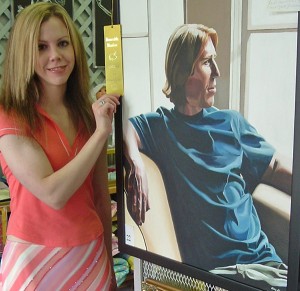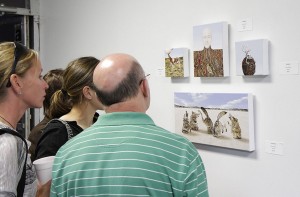As a busy artist, I am always updating my resume to add exhibitions or press items. One thing I can’t stress enough is the importance to stay on top of updating your resume. You never know when a gallery or a collector may ask for it and you don’t want to hand over an outdated resume or keep them waiting while you work on one. And it’s easy to forget to include something. So here are a few guidelines that I follow for my own resume (or CV) that may come in handy for those of you in need of an update or those just starting out. These are the categories in order of appearance:
Birthdate and Birthplace: I just put my year of birth, but you can use your full birthdate. This is important to collectors and galleries since they are interested in how your age and where you are from may influence your work.
Exhibitions: Depending on where you are at in your career, this may be one category or two. In the latter, you will have a Solo Exhibition category and a Group Exhibition category. Some like to put 2-person shows in with Solo. In that case, it should be clearly marked as Solo and Two-Person Exhibitions and list each exhibit as such.
For those of you just starting out, don’t fret. Everyone has to start somewhere. If you have ever shown your work in a coffee shop, restaurant, library, bank, etc. now is the time to list it. If you were the only artist, list it as a solo exhibit. What if you haven’t shown at all yet? I would start small- ask owners of businesses (if you know them personally, even better) if you can hang your work there for a month. If you know of a vacant space that you can use, put up an exhibit of your own and invite people for an opening reception. Even if it’s for one evening, it’s still an exhibit. These opportunities are easier to come across since no one is expecting you to make money for them, so they are more willing to let you use their walls. However, once you start getting exhibits at galleries, you should remove these previous shows from your resume. It’s okay when you’re just starting out, but once you start moving up the ladder, you will need to omit exhibits that are of “less importance” in the gallery owner’s eyes. This rule goes for everyone.
List exhibitions by most recent first. List the year, name of the exhibit, and the location. If there is an exhibit catalogue, put “(catalogue)” at the end of the listing. If there was a well-known curator or juror, list them as well.
Experience: I use the term “experience” here, but really this will depend on you. This spot should be reserved for any jobs, lectures, workshops, etc. that you may have (or had) pertaining to your art career. ONLY list something if it is relevant to your career. Even if you are an Executive Director, 20 years going, at a major department store chain, do not put it down. Unless this is evident by looking at your art, it is not important to your art career in any way other than a paycheck. If you are an art teacher, list your teaching experience, or if you’ve ever been a guest artist lecturer, list lectures, etc.
Education: This is an important category, but as I have learned from various sources, it shouldn’t be at the top of your resume. Your exhibition history is more important. So obviously this area won’t need much updating unless you are presently in school or going back. You should name your university, location, degree received, and the year. If your degree is not art related, or does not influence your art, you may want to leave off what your degree is in. More than likely, no one will ask anyway. From experience, only other artists and art professors ever ask where I studied.
If you have not attended college, don’t worry about that either. Many artists are self-taught. You may list such on your resume or if you’ve ever taken another artist’s workshop, you can put this under Education as well. As you move up the ranks, you may want to eventually remove the workshops unless they were conducted by well-known artists (i.e. nationally or internationally recognized). As your career progresses and you gain exposure, no gallery is going to care about a workshop you took 10 years ago. Not to say it wasn’t important to you, but galleries want to know what is most significant to your career.
Awards: Again, this is a category that depends on you. This may not be a blue ribbon award category so much as it is a list of grants received or residencies you were selected for. If you have received an award ribbon, certificate, etc. be sure to list the name of the competition and what placement you received. If you received a purchase award, be sure to name the award- for example, most are a person’s name such as the Betty Sue Purchase Award. If you don’t have any awards yet, just leave this category out.
Bibliography: Well, back in college, I learned the proper way to list press articles, etc. from “The Little, Brown Handbook.” I assume it still exists, but no two artists ever list their bibliographies the same. Some group everything by year, some alphabetical by article name, some alphabetical by author name, etc. I list by author name, but to each his own here. Regardless, this category should include any magazine articles, newspapers, radio interviews, tv interviews, and even blogs. Back in the day, blogs weren’t even in existence in “The Little, Brown Handbook.” Our books were stone tablets… just kidding.
Collections: Again, if you don’t have anything for this, just omit it. However, if your work is in any public collections, list it here. If your work is in any private collections (which is more likely the case), you can list the names and locations of the collectors if they are well-known (i.e. celebrities or famous patrons of the arts). Sorry to say, but no gallery is interested in knowing that your next door neighbor owns your work even if it’s 50 pieces. However, if the person is seen on national television or they are a famous artist, well-known curator, or a major art collector that loans their collection to museums from time to time, then you’ll get a gallery’s attention.
Representation: Another category you can omit if needed. If you happen to have gallery representation, list it here.
So that’s it- you may find in your career that there are other categories you could include, which is fine, just be sure your exhibitions stay at the forefront. Oh, and be sure your contact information is on every page of your resume. And no staples.
www.AmyGuidry.com





